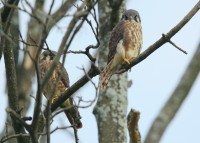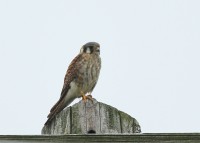American Kestrel male
July 17, 2014 in American Kestrel
July 17, 2014 in American Kestrel
July 7, 2014 in American Kestrel
June 26, 2014 in American Kestrel
 Flight agility increases noticeably during first week after nest departure, as flutter-glide is mostly replaced by deep wing-beats. Young appear hyperactive, changing perches frequently, attempting to pounce on various objects (including butterflies), performing exaggerated head-bobbing and tail-pumping intention movements, and emitting whine calls. Initially, parents deliver food to young; fledglings approach parents for food exchange by 1–2 wk postfledging. In post fledging mode we look for: perch-resting and preening to decrease, while perch-hunting, flying, and eating self-captured prey increase. Perch-hunting success peaks at 3 weeks, at which time begging behavior ceases. This parent and young were seen just east of the 250 Canal St. complex in Lawrence.
Flight agility increases noticeably during first week after nest departure, as flutter-glide is mostly replaced by deep wing-beats. Young appear hyperactive, changing perches frequently, attempting to pounce on various objects (including butterflies), performing exaggerated head-bobbing and tail-pumping intention movements, and emitting whine calls. Initially, parents deliver food to young; fledglings approach parents for food exchange by 1–2 wk postfledging. In post fledging mode we look for: perch-resting and preening to decrease, while perch-hunting, flying, and eating self-captured prey increase. Perch-hunting success peaks at 3 weeks, at which time begging behavior ceases. This parent and young were seen just east of the 250 Canal St. complex in Lawrence.
June 25, 2014 in American Kestrel
 The fledgling stage takes place typically at around 28–31 days. Fledging of entire brood may occur over several days, reflecting some hatching asynchrony. First flight likely to be a flutter-glide that may be short or less than 200 yards with first landings typically awkward. Young kestrels are dependent on parents for food for about 12–14 days after fledging. During first 2 wk, siblings perch close together, usually within a few yards. Allopreening and beaking (nibbling directed toward another’s bill or lore area) reported with great frequency. This young kestrel was seen atop the roof at the east end of 250 Canal Street complex in Lawrence.
The fledgling stage takes place typically at around 28–31 days. Fledging of entire brood may occur over several days, reflecting some hatching asynchrony. First flight likely to be a flutter-glide that may be short or less than 200 yards with first landings typically awkward. Young kestrels are dependent on parents for food for about 12–14 days after fledging. During first 2 wk, siblings perch close together, usually within a few yards. Allopreening and beaking (nibbling directed toward another’s bill or lore area) reported with great frequency. This young kestrel was seen atop the roof at the east end of 250 Canal Street complex in Lawrence.April 28, 2014 in American Kestrel
 The Kestrels have returned again to Lawrence for another breeding season! Today was the first sighting of a male kestrel near the Duck Bridge along the Merrimack River.
The Kestrels have returned again to Lawrence for another breeding season! Today was the first sighting of a male kestrel near the Duck Bridge along the Merrimack River.
According to Mass Audubon, the adult male, which has blue wings, two sharp, vertical, black stripes contrasting against a light face, and a bright rufous tail, is certainly the most colorful of North American hawks. The somewhat larger female is not as brilliant as the male and has its upperparts entirely rufous, and barred with black. Kestrels tend to perch high and conspicuously in the open, making them easily visible. They can be tamed readily and will reproduce in confinement. Many falconers have noted that the small males are more docile and tractable than the females.
Spring migration occurs mainly during March and April, and by the latter month local breeders are on their territories at woodland borders, fields, pastures, and the edges of highways. As the breeding season approaches, kestrels abandon their solitary winter habits. Members of a pair often perch side by side, and courtship consists of aerial displays by the male above a perched or flying female. The male ascends on rapidly fluttering wings and then plunges steeply, giving the familiar, repetitive killy-killy or kee-kee call, which is used not only in courtship but also at other times of excitement. Copulation during this period is frequent and precedes egg laying by several weeks.
February 26, 2014 in American Kestrel
 This winter has offered up a number of sightings of this male American Kestrel in and around Incinerator Road in Lawrence. It has been perched on utility poles and wires around the ballfield next to the Essex County Correctional facility, more commonly known as “The Farm.” This Kestrel is hopefully maintaining his territory for the breeding season….stay tuned!
This winter has offered up a number of sightings of this male American Kestrel in and around Incinerator Road in Lawrence. It has been perched on utility poles and wires around the ballfield next to the Essex County Correctional facility, more commonly known as “The Farm.” This Kestrel is hopefully maintaining his territory for the breeding season….stay tuned!
November 21, 2013 in American Kestrel
 After watching the Bald Eagle show, departed by way of the playing fields next to The Essex County Sheriff’s Department Correctional Center. Noticed a small bird atop one of the ventilator fans over the former landfill area. Walked a bit closer to discover a male American Kestrel. What a beauty! It the moved to the top of the nearby baseball field backstop, and this move allowed for a nice action/landing photo. A few more photos of the Kestrel posted here: http://www.pbase.com/birdshots/image/153476114
After watching the Bald Eagle show, departed by way of the playing fields next to The Essex County Sheriff’s Department Correctional Center. Noticed a small bird atop one of the ventilator fans over the former landfill area. Walked a bit closer to discover a male American Kestrel. What a beauty! It the moved to the top of the nearby baseball field backstop, and this move allowed for a nice action/landing photo. A few more photos of the Kestrel posted here: http://www.pbase.com/birdshots/image/153476114
July 8, 2013 in American Kestrel
 After a long waiting period with very regular intervals of watching, finally had a chance to see the two female Kestrel fledglings from this new nest location. They perched in the leafless nearby tree where the parents regularly perch during the day. Althought tough to find at times due to the many branches and their perfect coloration, quite a treat to get these looks!
After a long waiting period with very regular intervals of watching, finally had a chance to see the two female Kestrel fledglings from this new nest location. They perched in the leafless nearby tree where the parents regularly perch during the day. Althought tough to find at times due to the many branches and their perfect coloration, quite a treat to get these looks!
June 18, 2013 in American Kestrel
June 13, 2013 in American Kestrel
 Kestrels continue to be very visible around nest site with frequent forays to ward off the young nearby Peregrine fledglings. The peregrines are constantly exercising thier flight muscles with all kinds of new flight patterns. Wathcing the two species co-exist in adjacent locations will get more interesting once the Kestrel chicks join the scene!
Kestrels continue to be very visible around nest site with frequent forays to ward off the young nearby Peregrine fledglings. The peregrines are constantly exercising thier flight muscles with all kinds of new flight patterns. Wathcing the two species co-exist in adjacent locations will get more interesting once the Kestrel chicks join the scene!
3 photos posted from heavy overcast morning: http://www.pbase.com/birdshots/image/150787537 Click “next” upper right to advance frames…enjoy!